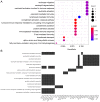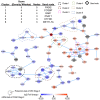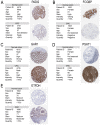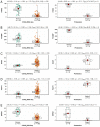Integrating proteomics and transcriptomics for the identification of potential targets in early colorectal cancer
- PMID: 31268166
- PMCID: PMC6615923
- DOI: 10.3892/ijo.2019.4833
Integrating proteomics and transcriptomics for the identification of potential targets in early colorectal cancer
Abstract
Colorectal cancer (CRC) is one of the most common malignancies worldwide. At present, CRC can often be treated upon diagnosis at stage I or II, or when dysplasia is detected; however, 60‑70% of cases are not diagnosed until they have developed into late stages of the disease or until the malignancy is identified. Diagnosis of CRC at an early stage remains a challenge due to the absence of early‑stage‑specific biomarkers. To identify potential targets of early stage CRC, label‑free proteomics analysis was applied to paired tumor‑benign tissue samples from patients with stage II CRC (n=21). A total of 2,968 proteins were identified; corresponding RNA‑Sequencing data were retrieved from The Cancer Genome Atlas‑colon adenocarcinoma. Numerous bioinformatics methods, including differential expression analysis, weighted correlation network analysis, Gene Ontology and protein‑protein interaction analyses, were applied to the proteomics and transcriptomics data. A total of 111 key proteins, which appeared as both differentially expressed proteins and mRNAs in the hub module, were identified as key candidates. Among these, three potential targets [protein‑arginine deiminase type‑2 (PADI2), Fc fragment of IgG binding protein (FCGBP) and phosphoserine aminotransferase 1] were identified from the pathological data. Furthermore, the survival analysis indicated that PADI2 and FCGBP were associated with the prognosis of CRC. The findings of the present study suggested potential targets for the identification of early stage CRC, and may improve understanding of the mechanism underlying the occurrence of CRC.
Figures









Similar articles
-
Identification of hub genes in colorectal cancer based on weighted gene co-expression network analysis and clinical data from The Cancer Genome Atlas.Biosci Rep. 2021 Jul 30;41(7):BSR20211280. doi: 10.1042/BSR20211280. Biosci Rep. 2021. PMID: 34308980 Free PMC article.
-
Identification of potential hub genes via bioinformatics analysis combined with experimental verification in colorectal cancer.Mol Carcinog. 2020 Apr;59(4):425-438. doi: 10.1002/mc.23165. Epub 2020 Feb 16. Mol Carcinog. 2020. PMID: 32064687
-
Identification of a five-gene signature with prognostic value in colorectal cancer.J Cell Physiol. 2019 Apr;234(4):3829-3836. doi: 10.1002/jcp.27154. Epub 2018 Aug 21. J Cell Physiol. 2019. PMID: 30132881
-
Transcriptomic Signatures in Colorectal Cancer Progression.Curr Mol Med. 2023;23(3):239-249. doi: 10.2174/1566524022666220427102048. Curr Mol Med. 2023. PMID: 35490318 Review.
-
Cancer stem cells in colorectal cancer: a review.J Clin Pathol. 2018 Feb;71(2):110-116. doi: 10.1136/jclinpath-2017-204739. Epub 2017 Sep 23. J Clin Pathol. 2018. PMID: 28942428 Review.
Cited by
-
A panel of DNA methylation markers for the classification of consensus molecular subtypes 2 and 3 in patients with colorectal cancer.Mol Oncol. 2021 Dec;15(12):3348-3362. doi: 10.1002/1878-0261.13098. Epub 2021 Sep 30. Mol Oncol. 2021. PMID: 34510716 Free PMC article.
-
Prognostic and immunological roles of Fc fragment of IgG binding protein in colorectal cancer.Oncol Lett. 2021 Jul;22(1):526. doi: 10.3892/ol.2021.12787. Epub 2021 May 13. Oncol Lett. 2021. PMID: 34055091 Free PMC article.
-
FCGBP functions as a tumor suppressor gene in head and neck squamous cell carcinoma.Discov Oncol. 2024 Nov 24;15(1):704. doi: 10.1007/s12672-024-01607-8. Discov Oncol. 2024. PMID: 39580769 Free PMC article.
-
Mucus, commensals, and the immune system.Gut Microbes. 2022 Jan-Dec;14(1):2041342. doi: 10.1080/19490976.2022.2041342. Gut Microbes. 2022. PMID: 35239459 Free PMC article. Review.
-
Hyaluronic Acid 35 kDa Protects against a Hyperosmotic, Formula Feeding Model of Necrotizing Enterocolitis.Nutrients. 2022 Apr 24;14(9):1779. doi: 10.3390/nu14091779. Nutrients. 2022. PMID: 35565748 Free PMC article.
References
-
- Weinberg BA, Marshall JL, Salem ME. The Growing Challenge of Young Adults With Colorectal Cancer. Oncology (Williston Park) 2017;31:381–389. - PubMed
MeSH terms
Substances
LinkOut - more resources
Full Text Sources
Medical
Research Materials
Miscellaneous

